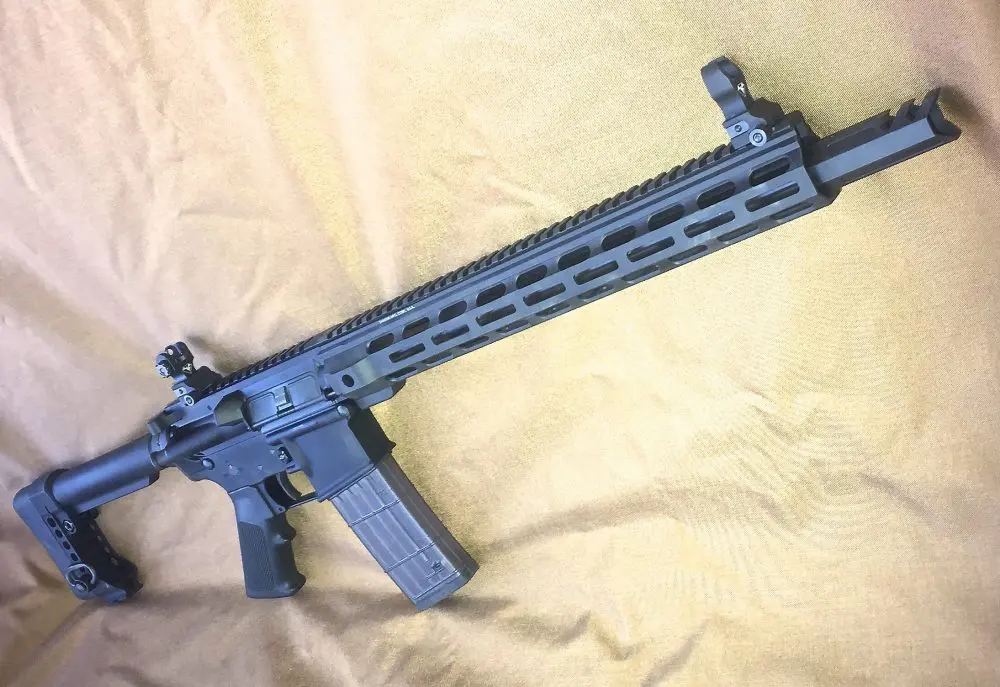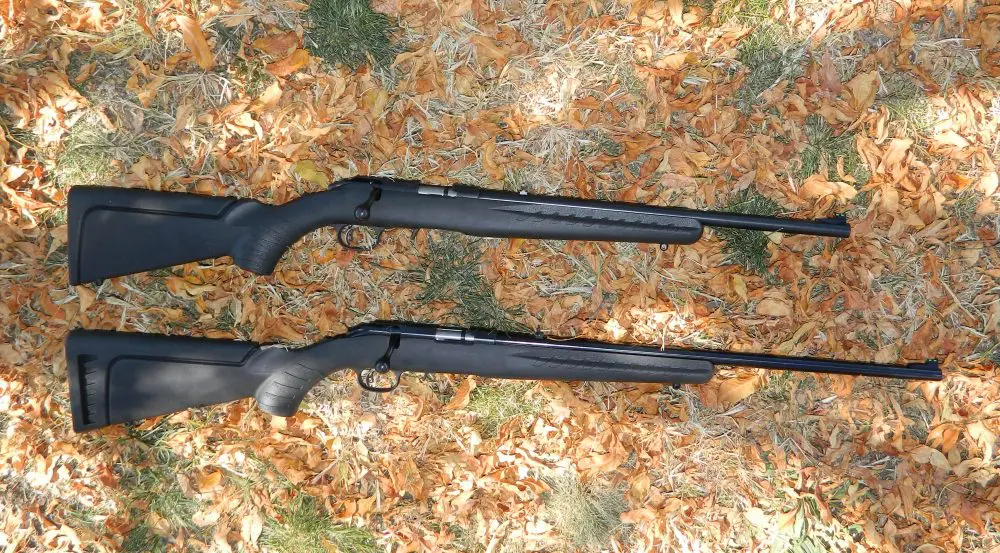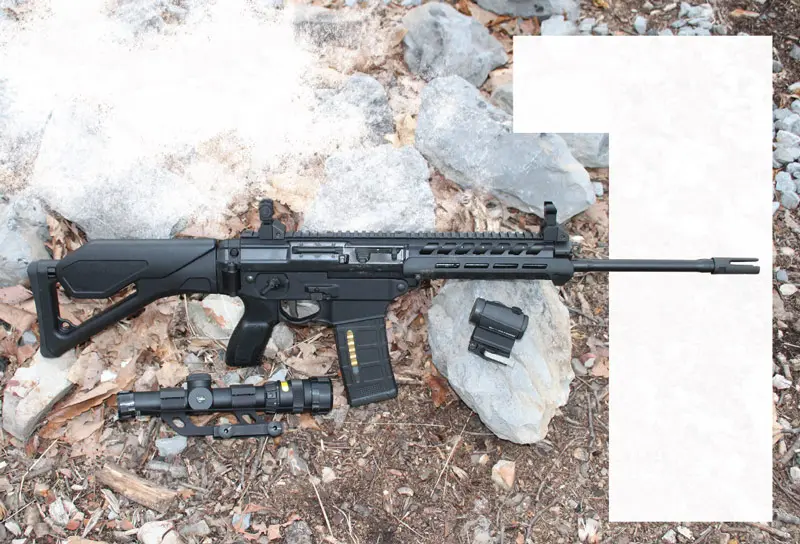
When it comes to choosing a modern-style rifle, there is little doubt the U.S. consumer prefers the AR platform. Of late, the AK series seems to be gaining a grudging acceptance as well. Each rifle type not only has burgeoning ammunition sales, but also after-market accessory popularity that supports these statements. Both have stereotypes that are not necessarily true. AKs are more accurate and have better ergonomics when viewed through a fighting rifle lens. ARs are much more reliable than most give them credit for.
It’s easy to forget viable options exist outside the iconic AK and AR platforms. In fact, the rifle design that has become one of my favorites blends aspects from both the AR and AK combined with unique characteristics of its own. I am talking about the SIG Sauer 556 in its recently redesigned SIG556xi form.
Certain weapons can morph into legendary status in consumer minds. This is often initiated by restricted supply of the weapon, which increases the desire to possess. This can be caused by limited production or more likely onerous import restrictions imposed on the market by the Federal government. The SIG550/551 series of rifles is definitely such a weapon.

Table of Contents
GENESIS
The SIG550/551 design dates back to the late 1970s, as the Swiss sought to replace their Stgw 57 battle rifle. From the beginning, specifications highlighted the desire for a modular design with model variants such as compact and marksman type weapons. The SIG 550 and Sig Sauer 551 functions via a long-stroke adjustable gas piston with a rotating bolt-carrier group very similar to the AK’s in configuration but with Swiss refinements.
Many in the U.S. market waited on SIG Sauer’s entry into the black rifle market. The hope was to get a civilian-legal version of the legendary Swiss Army SIG 550 series of rifles. SIG Sauer designers chose a compromise in the form of the SIG 556. Its trigger housing was altered from the 550 series to accept AR-15 magazines. Overall, this is a sage decision considering the sheer number of AR-15 magazines in the U.S.
However, the proven two-position gas-adjustable gas-piston operating rod system found on the 550 series was maintained in the original 556’s design. The SIG556 line-up eventually included a 556 Russian model chambered in 7.62x39mm that accepted AK magazines.

SIG556xi
The SIG556xi further builds upon its predecessors with its modularity—not only in terms of furniture and accessories, but also caliber. Currently a user can choose and change among three calibers—5.56, 7.62×39, and .300 Blackout— via simple barrel and bolt-head changes, as well as which magazine type is used by changing lowers.
With the SIG556xi, the upper receiver is the serial numbered part, not the lower receiver as with the AR-15. Forend and rear stock furniture is easily tailored to preference, as is barrel length.
While the SIG556 product line accepts AR-15/M16 magazines, it is closer to the Kalashnikov in actual operating method. This was brought home when SIG Sauer introduced the SIG556 Russian chambered in 7.62x39mm using AK magazines thanks to a modified lower.
The SIG Sauer operating rod system has been referred to as the Porsche of AK designs due to the tighter tolerances and better workmanship found in SIG Sauer weapons compared to other manufacturers using the AK as a basis of design. The gas-piston operating system keeps the action cleaner, cooler and overall more reliable. It also allows the use of side-folding stocks to reduce the overall dimensions of the rifle. These are all positive attributes, especially considering the recent rush to create gas-piston ARs due to the perceived increased reliability factor.
The SIG556xi features a flattop upper receiver with Picatinny rail for mounting optics or other aiming devices. The SIG556xi polymer forend accepts Magpul light and rail kits, while the aluminum and carbon-fiber forends accept two-, four-, and six-inch M1913 rails.

LIGHTER, HANDIER, EASIER
The SIG556xi is truly ambidextrous, featuring safety selectors and magazine releases on both sides of the receiver, along with a charging handle that is simple to switch to the left or right side of the bolt. Optional receiver end plates on the 556xi allow for the use of AR receiver extension tubes and buttstocks.
Chambered in 5.56, the SIG556xi weighs 7.5 pounds, measures 36 inches with stock unfolded and 27.1 inches folded. The three-prong flash hider uses a standard ½”x28 thread pattern.
SIG chose to use aircraft-grade aluminum alloy forgings for the redesigned trigger housing in the 556 compared to the 550 series, which saves weight. The SIG556xi has a 16¼-inch cold-hammer-forged barrel with 1:7 twist. As mentioned earlier, the 556xi can change its barrel to shorter lengths.
The SIG556xi benefits from further weight saving with SIG Sauer’s decision to use a shorter gas piston system compared to its brethren SIG556 models. Think of the standard AK-length piston compared to what is found in an AK Krinkov variant. Over a pound is shaved from the SIG556xi due to this shorter gas piston and resultant shorter forearm furniture. For many, this translates into a handier rifle that is not so front heavy.
The SIG556xi “upper” hinges open with the bolt group and gas piston removed with the trigger group exposed in the “lower.” The barrel and chamber are easily accessed for cleaning, as are the bolt group and piston rod. Overall, cleaning the SIG556xi takes little time. The bolt group needs little more than a wipe-off and re-lubrication.
A Nitron finish on the upper and hard-coat-anodized aluminum lower keep exterior concerns to a minimum. The factory folding stock once deployed is very sturdy and does not exhibit any side-to-side or up-and-down wiggle.
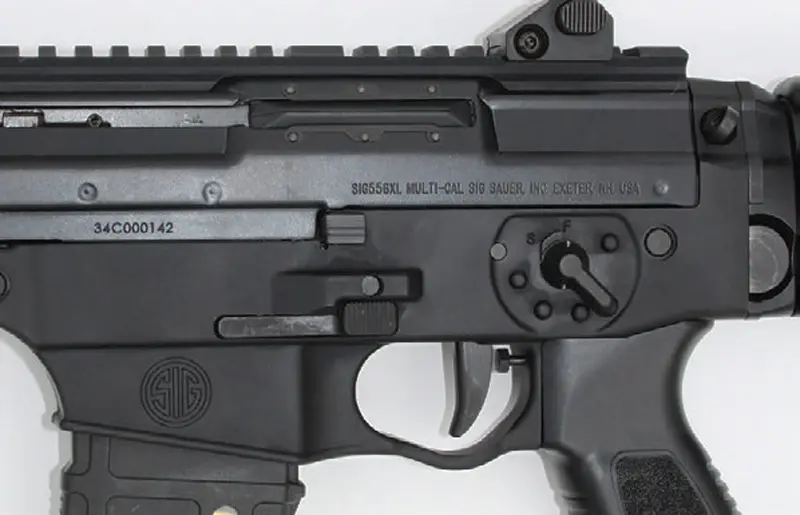
HITTING THE RANGE
The SIG Sauer 556xi was evaluated at Echo Valley Training Center (EVTC). This private facility has multiple 100- yard enclosed bays, the Jungle Walk, and a 360-degree drive-in range all capable of handling numerous students conducting square-range drills or more dynamic types of training. In conjunction with the individual training bays, EVTC features multi-stepped target berms strewn with reactive steel targets from TacStrike, fluid-drained automobiles, and moving targets at ranges from 100 out to 350 yards.
While foldable metallic iron sights come standard on the SIG556xi, I decided to take full advantage of the SIG556xi’s flattop upper by installing different optics for testing. A Trijicon Accupoint 1-4X TR24 scope was mounted on the SIG556xi, as was an Aimpoint T1 red dot. The Accupoint was chosen in the quest to find an optic as flexible as the 556xi, i.e., low magnification for up-close targeting and 4X for longer range.
The Aimpoint T1 is a well-regarded sight often found atop experienced operators’ rifles. The single-focus plane with the red dot is easier to shoot accurately than coordinating front and rear sights. The 5.56/.223’s flat trajectory aids in making center-mass hits out to 300 yards without having to compensate excessively for bullet drop.
Ammunition tested with the SIG556xi was a combination of Black Hills, Hornady, Winchester, and Federal Premium. The SIG556xi kept all loads tested under 2½ inches, with many loads doing significantly better. This accuracy level justifies possibly leaving a magnified optic such as the Trijicon Accupoint on the rifle, depending on the intended mission. Overall, the accuracy level was more than acceptable, especially considering the barrel’s thin .5-inch profile.
TRIGGER TROUBLES
If there was a negative with the SIG Sauer 556xi, it was its trigger, which feels like a cross between an AR and an AK. It is similar to two stage in that travel is encountered when first pulling it to the rear. The issue comes with the amount of travel.
When you think or would expect the trigger to break, more travel is needed, taken up to the point where it was awkward to pull the trigger in a way conducive to accuracy. The break comes as a surprise, but not in a positive way.
In short, it is problematic to stage the 556xi’s trigger for precise shots. With all this said, the reset is not particularly long, allowing a user to engage rapidly once accustomed to it. I have heard some say tongue in cheek that the SIG556 has a three-stage trigger. I have handled several other SIG556 rifles, with the current 556xi’s trigger being the worst. While the trigger is adjustable, it is important to relay how it was out of the box.
MAGAZINE-CHANGE DRILLS
Magazine-change drills with the 556xi turned out to be a combination of AR and AK manipulation techniques. The SIG556xi bolt does hold open after the last round is fired. So it was possible to insert a fresh magazine home and hit the bolt hold-open lever with the left hand to chamber a round, similar to an AR.
The SIG556xi controls are not direct clones of an AR’s, which an experienced AR user can sense during use. Along these same lines, the ambidextrous magazine release on the right side of the receiver needs to be depressed from the front to ensure best use. These are not meant as criticisms, just observations.
For the occasion when a magazine was changed without the bolt being held open or training doctrine dictated running the bolt every time, the user had to resort to a couple different methods, as with the AK. Your choice: reach over or under the rifle with your left hand and work the bolt, tilt the rifle over with the right hand on the pistol grip and work the action with the left hand, or switch the rifle over to the left hand and work the bolt with the right hand.
None of these techniques are particularly hard to master, but different from what dyed-in-the-wool AR operators are accustomed to. Some will be enticed to move the charging handle to the left side of the 556xi’s receiver, such as on an FN FAL. The user can keep the firing hand on the pistol grip and run the bolt without having to reach over/ under the receiver. This facilitates keeping the rifle oriented downrange and in the shoulder pocket.
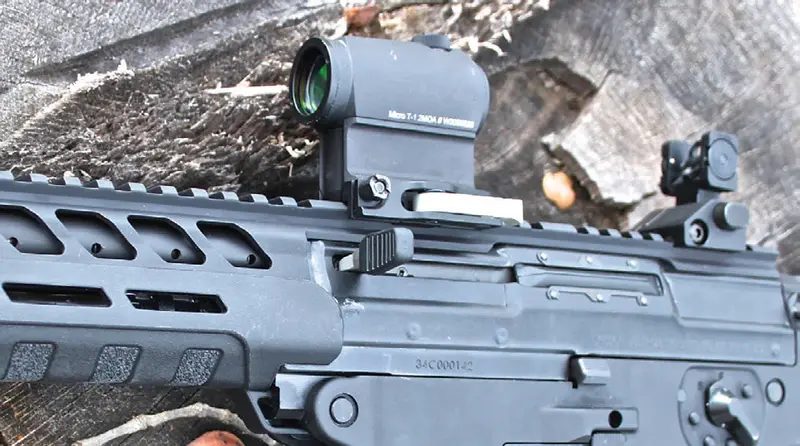
DYNAMIC DRILLS
Range testing of the SIG556xi consisted of repeating numerous drills and exercises experienced via training with several instructors. Firing while moving as well as behind cover, reloading drills, transitions between shoulders depending on cover orientation, and engaging multiple targets arranged around no-shoot targets all helped put the SIG556xi to the test.
Several of the more dynamic drills showed the SIG556xi at its best— unrelenting reliability even when scorching hot after multiple magazines fired consecutively. The 556xi’s gaspiston operating rod system proved its worth in keeping the bolt carrier group cleaner compared to direct-impingement AR rifles. Minimal recoil and handling characteristics allowed for fast double and triple taps on selected targets, especially at CQB distances.
I noted how vigorously the SIG556xi ejects fired cases, similar to AK-type weapons. To my mind, that reflects robust reliability. The number of rounds fired with no malfunctions further supports this.
The SIG556xi was pulled out of the shipping box, inspected, and put to work with the lubrication it arrived with. Nearly 1,000 rounds were fired for this T&E. For verification purposes, a variety of AR-15 magazines were used before settling with Magpul 30- and 40-round PMAGs.

CONCLUSIONS
The potential of the flexible and adaptable SIG556xi is hard to overemphasize. SIG Sauer tweaked the SIG556xi’s gas system from two settings associated with earlier 5.56 models—normal and adverse—to include a suppressed setting as well. This is a sure nod to the .300 Blackout chambering.
Different camps will be advocating the pros and cons of the SIG Sauer 556xi, which is typical within the firearms community. One platform to accommodate the two most popular calibers—5.56 and 7.62×39—along with their native magazines, combined with an up-and-coming caliber in the form of the .300 Blackout is hard to argue against.
While the SIG556xi will not displace the AR or AK in terms of popularity based on pure numbers sold, its owners will be well served by its capabilities. A certain satisfaction will be gained by knowing the SIG556xi’s heritage and how it incorporates and enhances features from both the AR and AK, as well as its own nuances.


